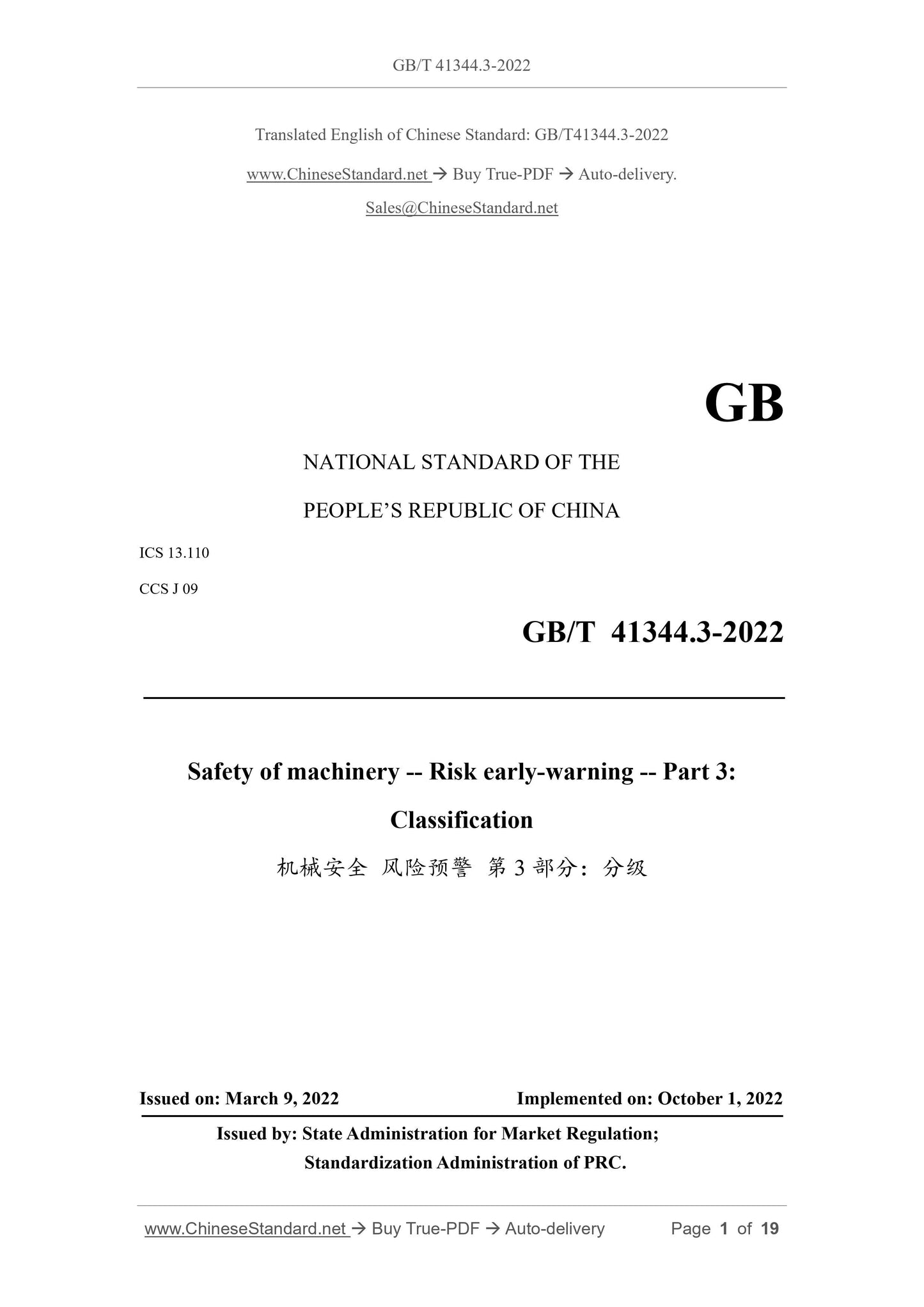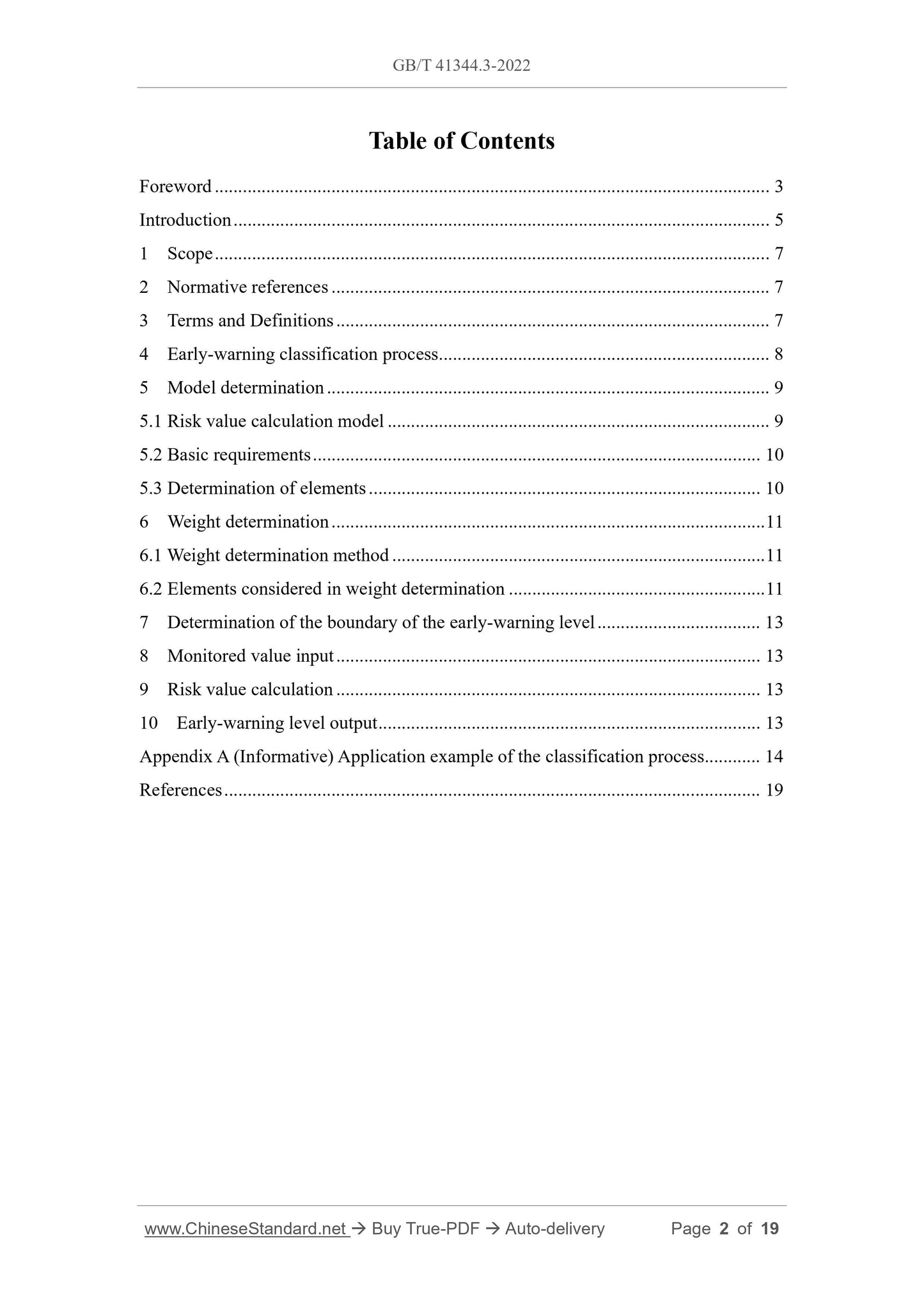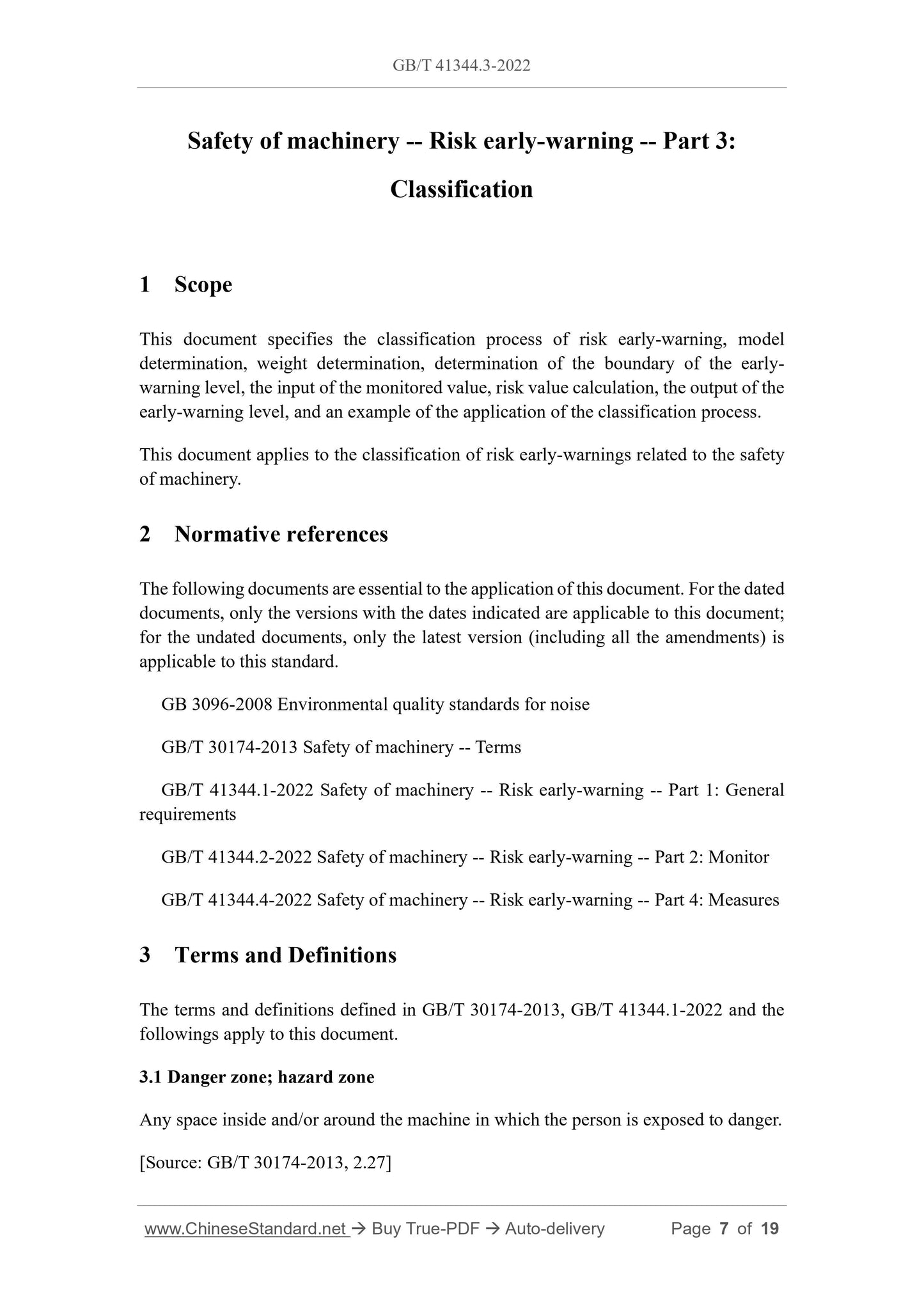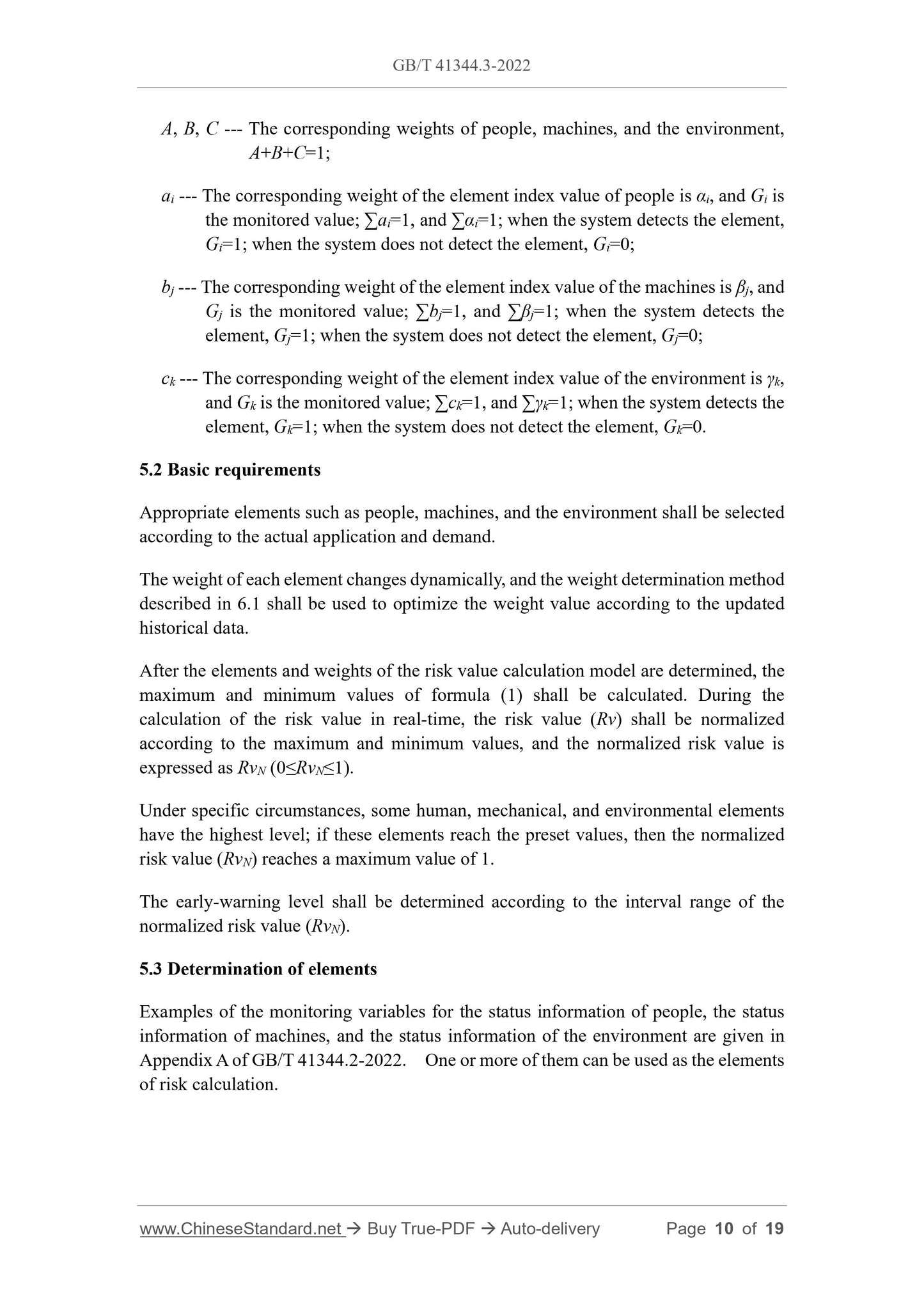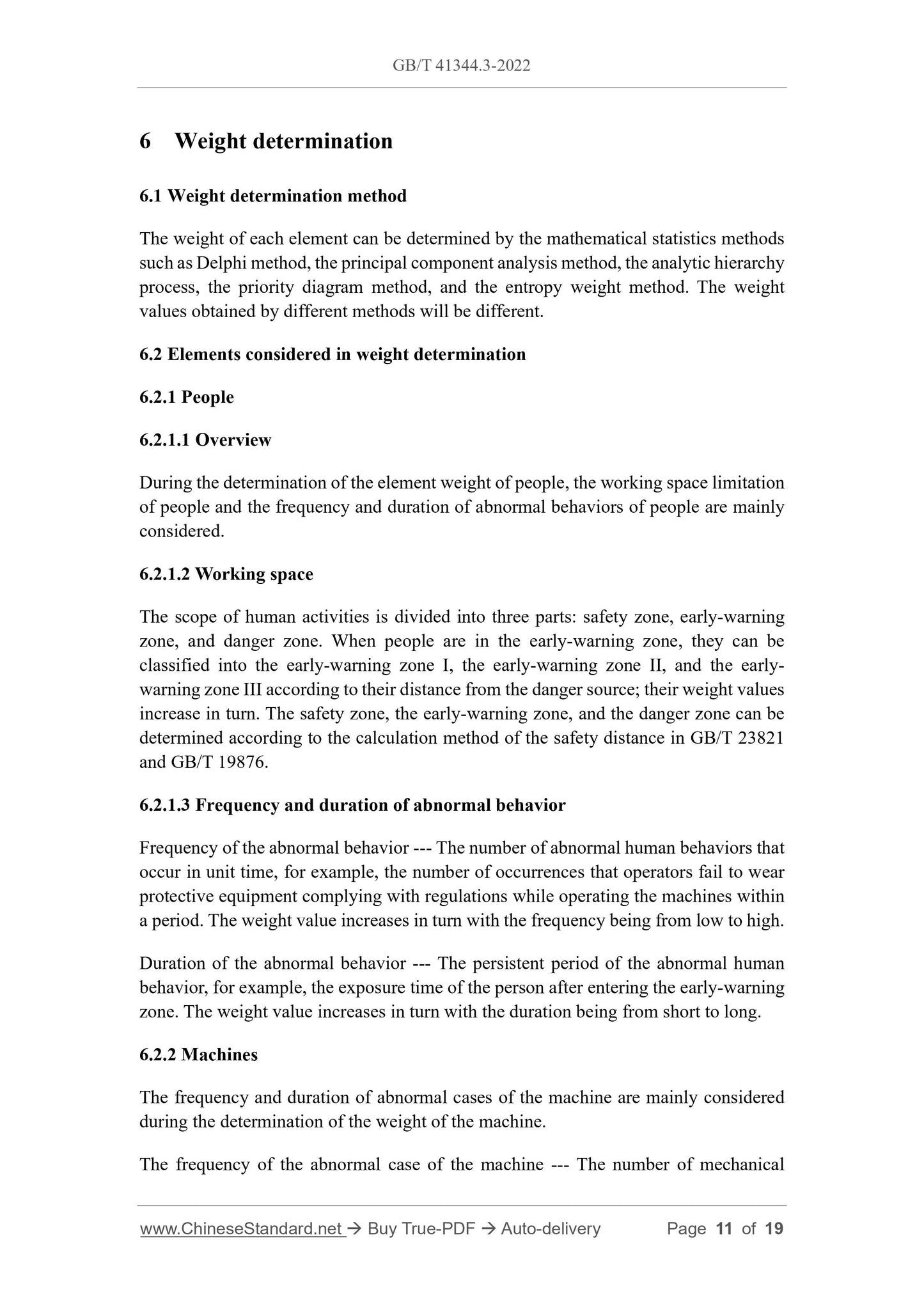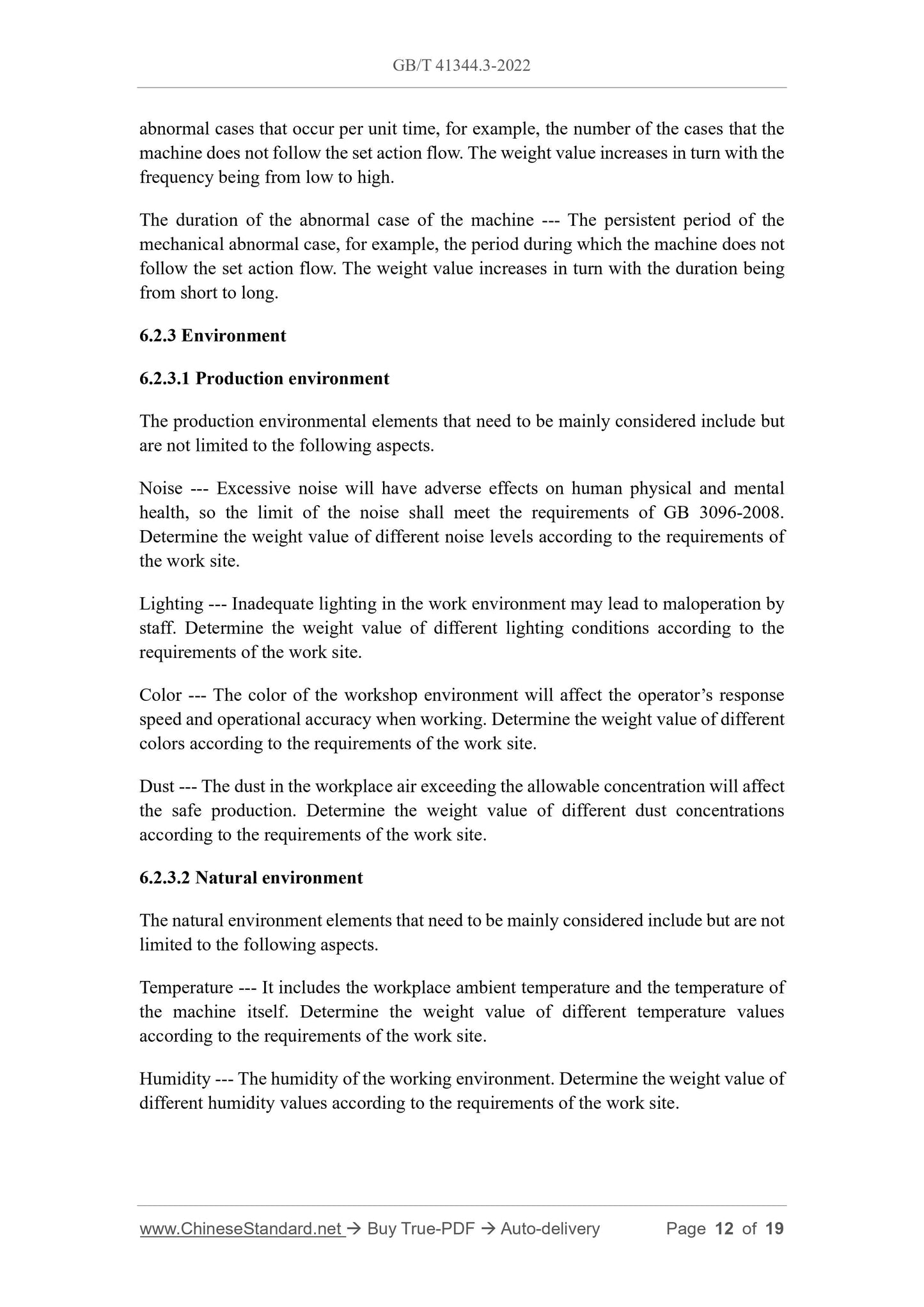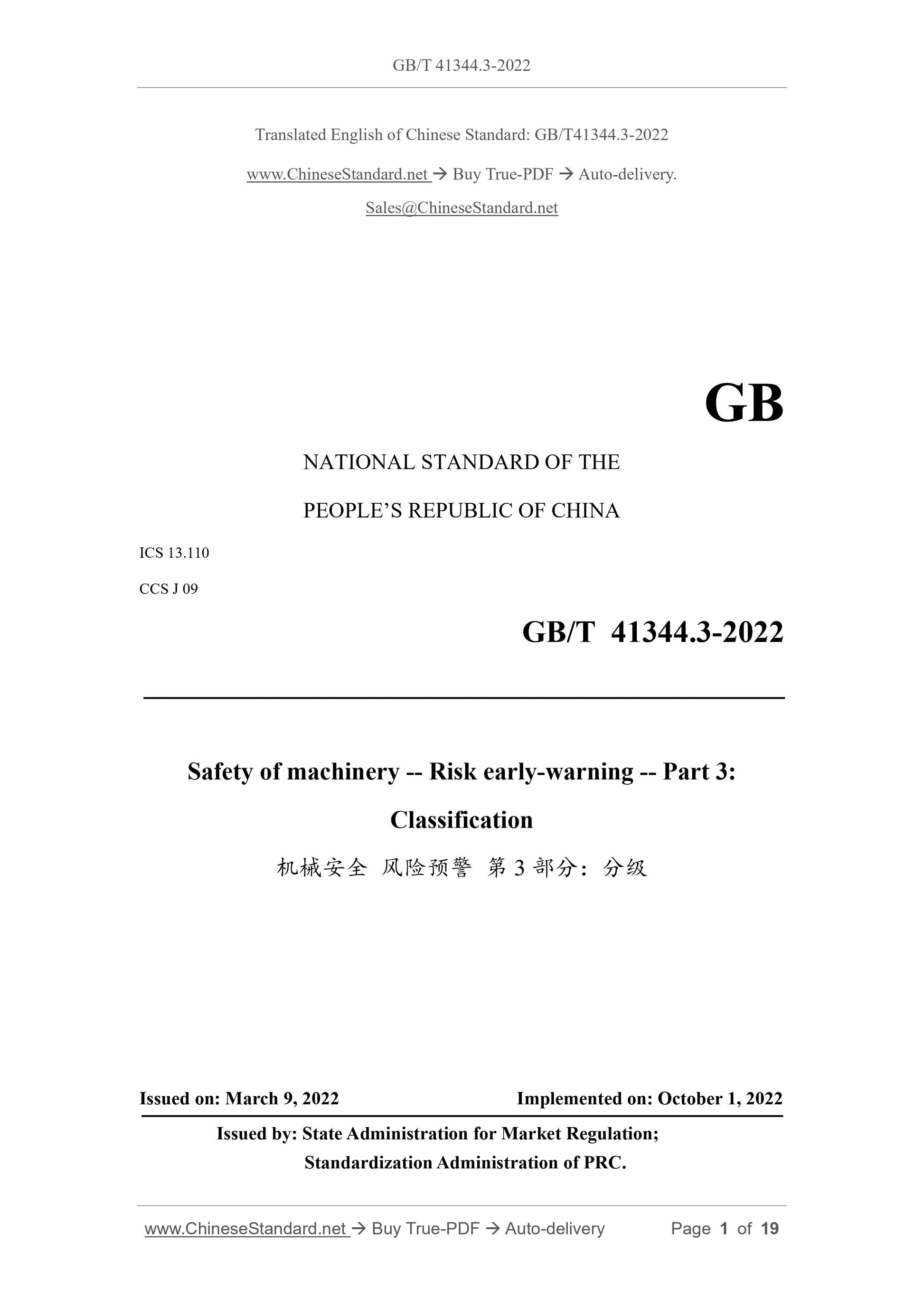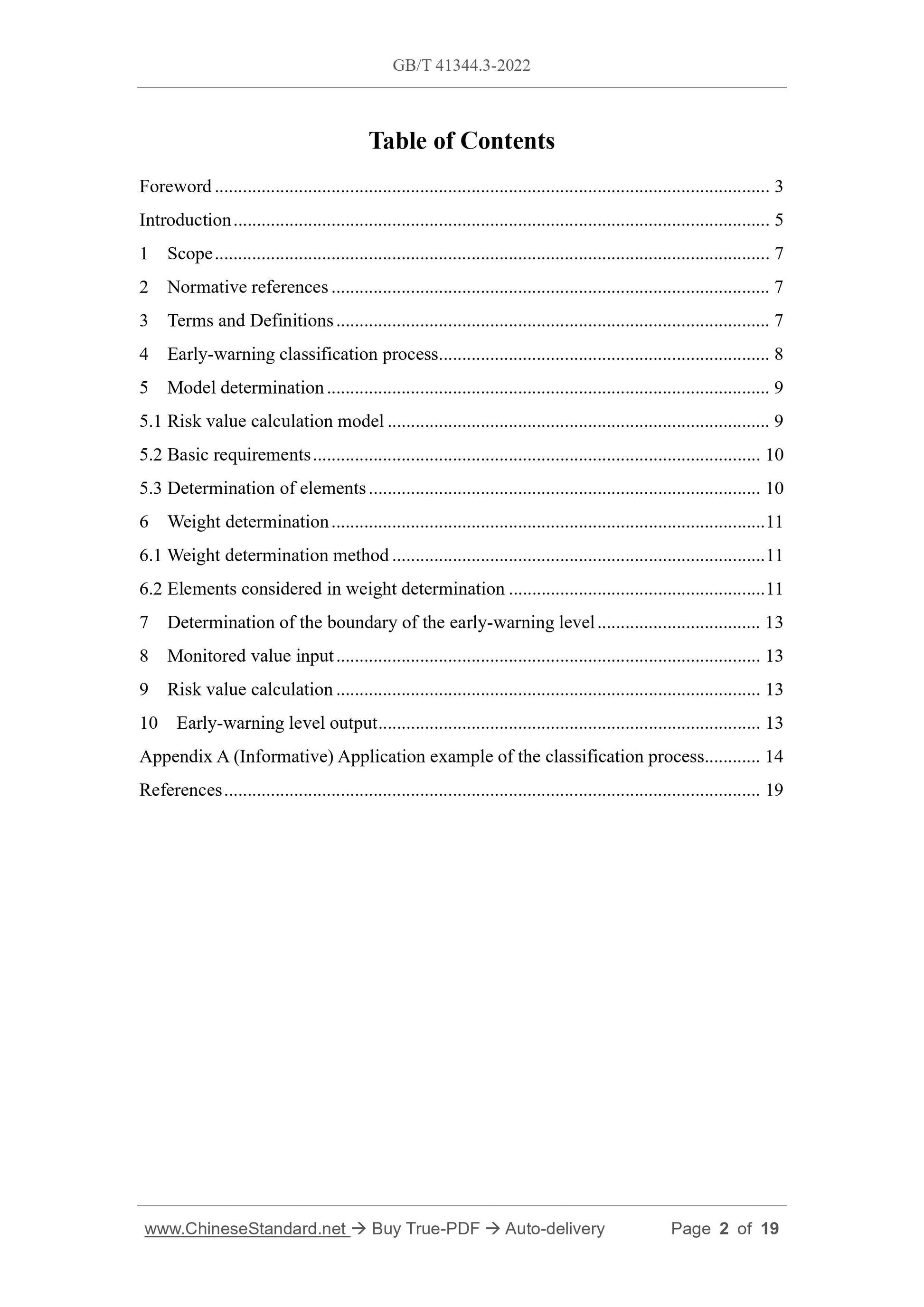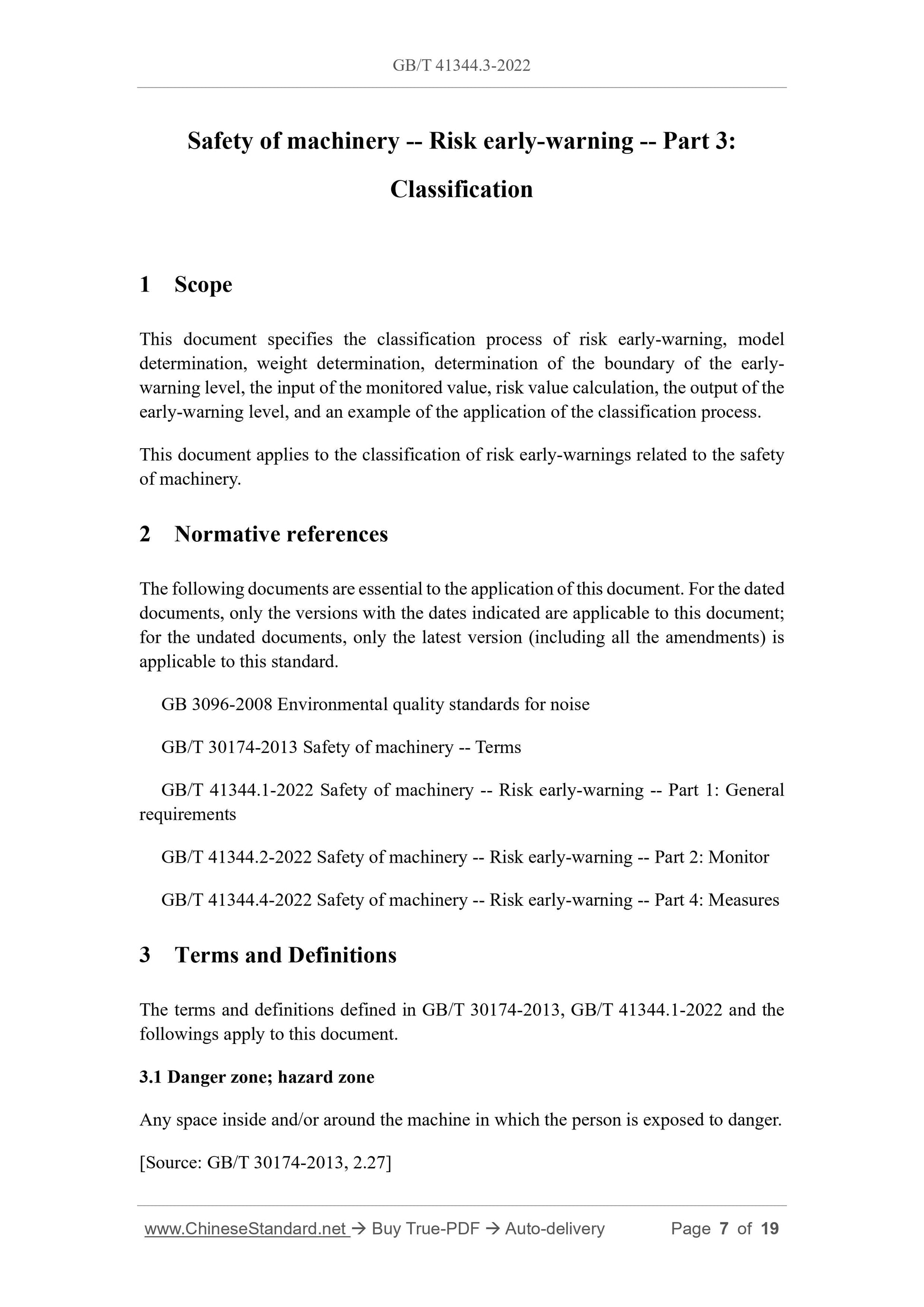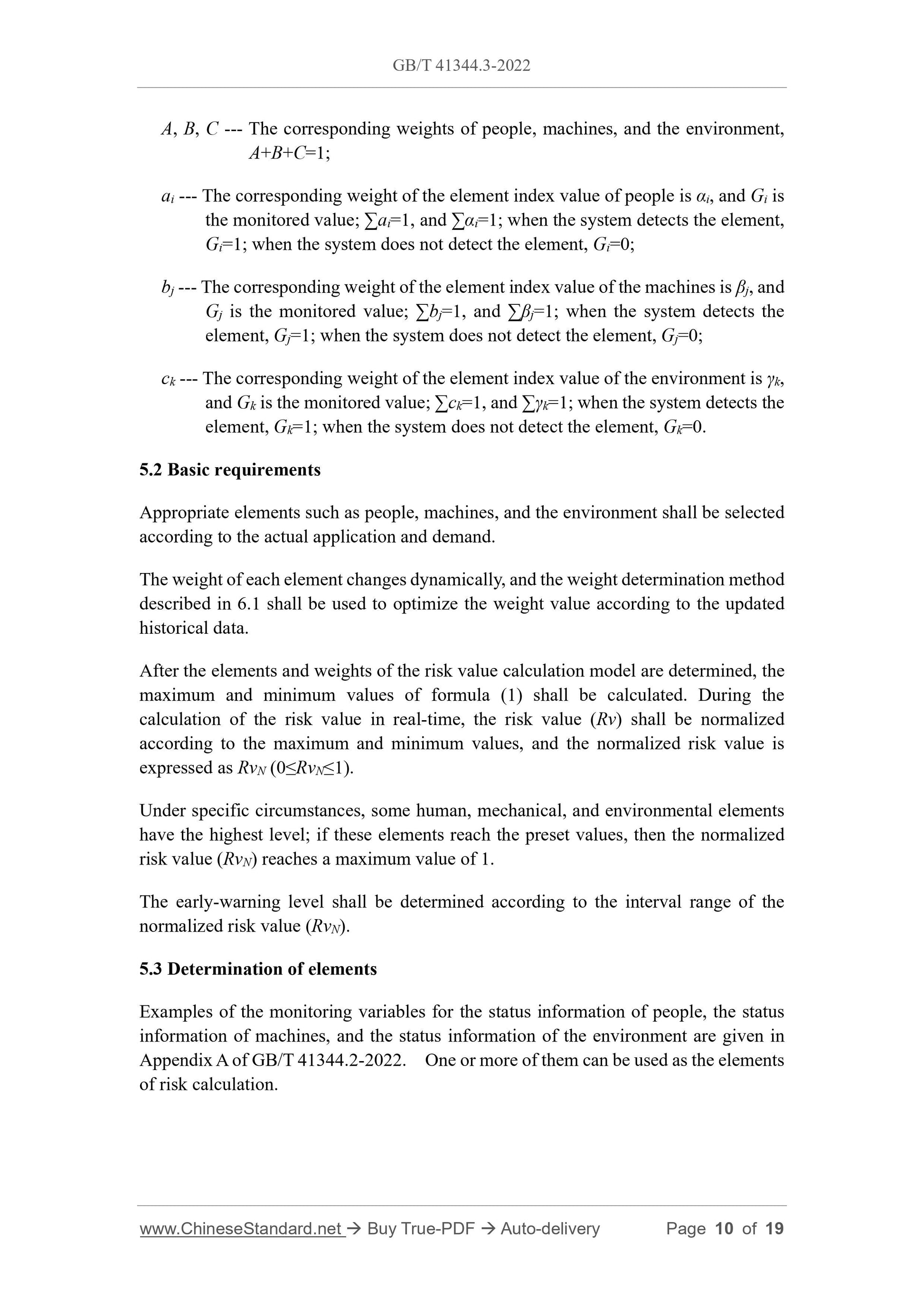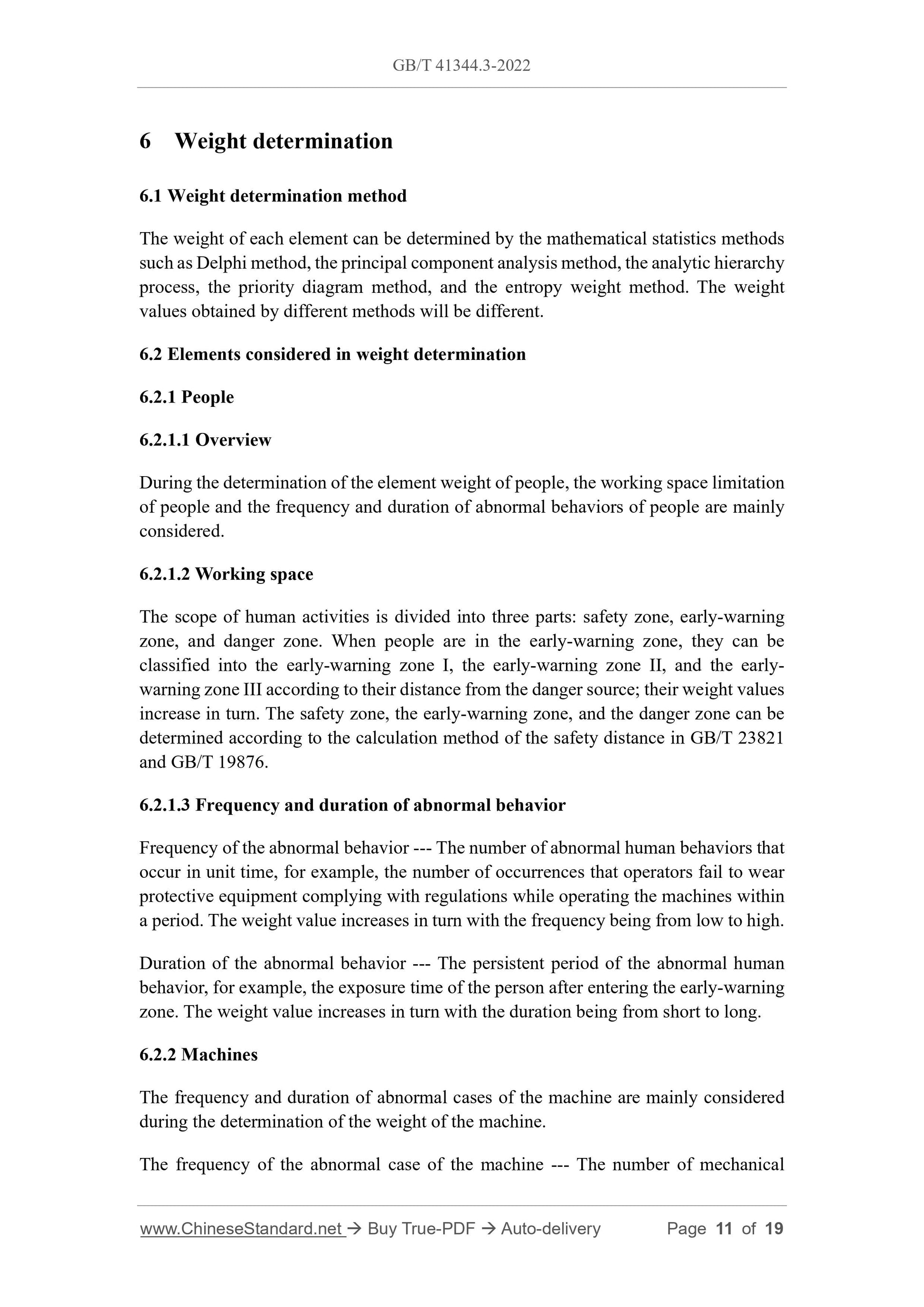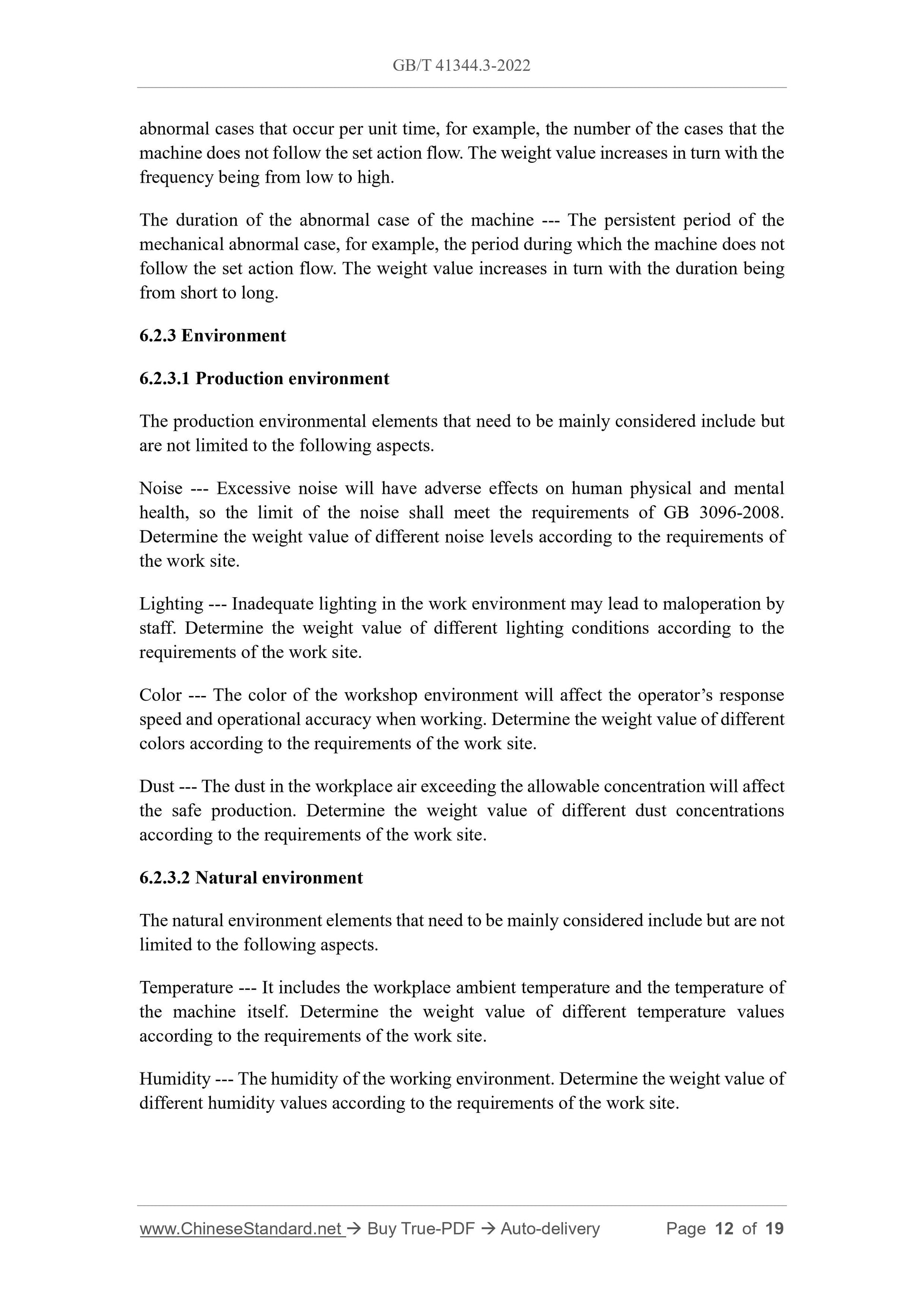1
/
of
6
PayPal, credit cards. Download editable-PDF and invoice in 1 second!
GB/T 41344.3-2022 English PDF (GBT41344.3-2022)
GB/T 41344.3-2022 English PDF (GBT41344.3-2022)
Regular price
$230.00 USD
Regular price
Sale price
$230.00 USD
Unit price
/
per
Shipping calculated at checkout.
Couldn't load pickup availability
Delivery: 3 seconds. Download true-PDF + Invoice.
Get QUOTATION in 1-minute: Click GB/T 41344.3-2022
Historical versions: GB/T 41344.3-2022
Preview True-PDF (Reload/Scroll if blank)
GB/T 41344.3-2022: Safety of machinery - Risk early-warning - Part 3: Classification
GB/T 41344.3-2022
NATIONAL STANDARD OF THE
PEOPLE’S REPUBLIC OF CHINA
ICS 13.110
CCS J 09
Safety of machinery -- Risk early-warning -- Part 3:
Classification
ISSUED ON: MARCH 9, 2022
IMPLEMENTED ON: OCTOBER 1, 2022
Issued by: State Administration for Market Regulation;
Standardization Administration of PRC.
Table of Contents
Foreword ... 3
Introduction ... 5
1 Scope ... 7
2 Normative references ... 7
3 Terms and Definitions ... 7
4 Early-warning classification process ... 8
5 Model determination ... 9
5.1 Risk value calculation model ... 9
5.2 Basic requirements ... 10
5.3 Determination of elements ... 10
6 Weight determination ... 11
6.1 Weight determination method ... 11
6.2 Elements considered in weight determination ... 11
7 Determination of the boundary of the early-warning level ... 13
8 Monitored value input ... 13
9 Risk value calculation ... 13
10 Early-warning level output ... 13
Appendix A (Informative) Application example of the classification process ... 14
References ... 19
Safety of machinery -- Risk early-warning -- Part 3:
Classification
1 Scope
This document specifies the classification process of risk early-warning, model
determination, weight determination, determination of the boundary of the early-
warning level, the input of the monitored value, risk value calculation, the output of the
early-warning level, and an example of the application of the classification process.
This document applies to the classification of risk early-warnings related to the safety
of machinery.
2 Normative references
The following documents are essential to the application of this document. For the dated
documents, only the versions with the dates indicated are applicable to this document;
for the undated documents, only the latest version (including all the amendments) is
applicable to this standard.
GB 3096-2008 Environmental quality standards for noise
GB/T 30174-2013 Safety of machinery -- Terms
GB/T 41344.1-2022 Safety of machinery -- Risk early-warning -- Part 1: General
requirements
GB/T 41344.2-2022 Safety of machinery -- Risk early-warning -- Part 2: Monitor
GB/T 41344.4-2022 Safety of machinery -- Risk early-warning -- Part 4: Measures
3 Terms and Definitions
The terms and definitions defined in GB/T 30174-2013, GB/T 41344.1-2022 and the
followings apply to this document.
3.1 Danger zone; hazard zone
Any space inside and/or around the machine in which the person is exposed to danger.
[Source: GB/T 30174-2013, 2.27]
A, B, C --- The corresponding weights of people, machines, and the environment,
A+B+C=1;
ai --- The corresponding weight of the element index value of people is αi, and Gi is
the monitored value; ∑ai=1, and ∑αi=1; when the system detects the element,
Gi=1; when the system does not detect the element, Gi=0;
bj --- The corresponding weight of the element index value of the machines is βj, and
Gj is the monitored value; ∑bj=1, and ∑βj=1; when the system detects the
element, Gj=1; when the system does not detect the element, Gj=0;
ck --- The corresponding weight of the element index value of the environment is γk,
and Gk is the monitored value; ∑ck=1, and ∑γk=1; when the system detects the
element, Gk=1; when the system does not detect the element, Gk=0.
5.2 Basic requirements
Appropriate elements such as people, machines, and the environment shall be selected
according to the actual application and demand.
The weight of each element changes dynamically, and the weight determination method
described in 6.1 shall be used to optimize the weight value according to the updated
historical data.
After the elements and weights of the risk value calculation model are determined, the
maximum and minimum values of formula (1) shall be calculated. During the
calculation of the risk value in real-time, the risk value (Rv) shall be normalized
according to the maximum and minimum values, and the normalized risk value is
expressed as RvN (0≤RvN≤1).
Under specific circumstances, some human, mechanical, and environmental elements
have the highest level; if these elements reach the preset values, then the normalized
risk value (RvN) reaches a maximum value of 1.
The early-warning level shall be determined according to the interval range of the
normalized risk value (RvN).
5.3 Determination of elements
Examples of the monitoring variables for the status information of people, the status
information of machines, and the status information of the environment are given in
Appendix A of GB/T 41344.2-2022. One or more of them can be used as the elements
of risk calculation.
6 Weight determination
6.1 Weight determination method
The weight of each element can be determined by the mathematical statistics methods
such as Delphi method, the principal component analysis method, the analytic hierarchy
process, the priority diagram method, and the entropy weight method. The weight
values obtained by different methods will be different.
6.2 Elements considered in weight determination
6.2.1 People
6.2.1.1 Overview
During the determination of the element weight of people, the working space limitation
of people and the frequency and duration of abnormal behaviors of people are mainly
considered.
6.2.1.2 Working space
The scope of human activities is divided into three parts: safety zone, early-warning
zone, and danger zone. When people are in the early-warning zone, they can be
classified into the early-warning zone I, the early-warning zone II, and the early-
warning zone III according to their distance from the danger source; their weight values
increase in turn. The safety zone, the early-warning zone, and the danger zone can be
determined according to the calculation method of the safety distance in GB/T 23821
and GB/T 19876.
6.2.1.3 Frequency and duration of abnormal behavior
Frequency of the abnormal behavior --- The number of abnormal human behaviors that
occur in unit time, for example, the number of occurrences that operators fail to wear
protective equipment complying with regulations while operating the machines within
a period. The weight value increases in turn with the frequency being from low to high.
Duration of the abnormal behavior --- The persistent period of the abnormal human
behavior, for example, the exposure time of the person after entering the early-warning
zone. The weight value increases in turn with the duration being from short to long.
6.2.2 Machines
The frequency and duration of abnormal cases of the machine are mainly considered
during the determination of the weight of the machine.
The frequency of the abnormal case of the machine --- The number of mechanical
abnormal cases that occur per unit time, for example, the number of the cases that the
machine does not follow the set action flow. The weight value increases in turn with the
frequency being from low to high.
The duration of the abnormal case of the machine --- The persistent period of the
mechanical abnormal case, for example, the period during which the machine does not
follow the set action flow. The weight value increases in turn with the duration being
from short to long.
6.2.3 Environment
6.2.3.1 Production environment
The production environmental elements that need to be mainly considered include but
are not limited to the following aspects.
Noise --- Excessive noise will have adverse effects on human physical and mental <...
Get QUOTATION in 1-minute: Click GB/T 41344.3-2022
Historical versions: GB/T 41344.3-2022
Preview True-PDF (Reload/Scroll if blank)
GB/T 41344.3-2022: Safety of machinery - Risk early-warning - Part 3: Classification
GB/T 41344.3-2022
NATIONAL STANDARD OF THE
PEOPLE’S REPUBLIC OF CHINA
ICS 13.110
CCS J 09
Safety of machinery -- Risk early-warning -- Part 3:
Classification
ISSUED ON: MARCH 9, 2022
IMPLEMENTED ON: OCTOBER 1, 2022
Issued by: State Administration for Market Regulation;
Standardization Administration of PRC.
Table of Contents
Foreword ... 3
Introduction ... 5
1 Scope ... 7
2 Normative references ... 7
3 Terms and Definitions ... 7
4 Early-warning classification process ... 8
5 Model determination ... 9
5.1 Risk value calculation model ... 9
5.2 Basic requirements ... 10
5.3 Determination of elements ... 10
6 Weight determination ... 11
6.1 Weight determination method ... 11
6.2 Elements considered in weight determination ... 11
7 Determination of the boundary of the early-warning level ... 13
8 Monitored value input ... 13
9 Risk value calculation ... 13
10 Early-warning level output ... 13
Appendix A (Informative) Application example of the classification process ... 14
References ... 19
Safety of machinery -- Risk early-warning -- Part 3:
Classification
1 Scope
This document specifies the classification process of risk early-warning, model
determination, weight determination, determination of the boundary of the early-
warning level, the input of the monitored value, risk value calculation, the output of the
early-warning level, and an example of the application of the classification process.
This document applies to the classification of risk early-warnings related to the safety
of machinery.
2 Normative references
The following documents are essential to the application of this document. For the dated
documents, only the versions with the dates indicated are applicable to this document;
for the undated documents, only the latest version (including all the amendments) is
applicable to this standard.
GB 3096-2008 Environmental quality standards for noise
GB/T 30174-2013 Safety of machinery -- Terms
GB/T 41344.1-2022 Safety of machinery -- Risk early-warning -- Part 1: General
requirements
GB/T 41344.2-2022 Safety of machinery -- Risk early-warning -- Part 2: Monitor
GB/T 41344.4-2022 Safety of machinery -- Risk early-warning -- Part 4: Measures
3 Terms and Definitions
The terms and definitions defined in GB/T 30174-2013, GB/T 41344.1-2022 and the
followings apply to this document.
3.1 Danger zone; hazard zone
Any space inside and/or around the machine in which the person is exposed to danger.
[Source: GB/T 30174-2013, 2.27]
A, B, C --- The corresponding weights of people, machines, and the environment,
A+B+C=1;
ai --- The corresponding weight of the element index value of people is αi, and Gi is
the monitored value; ∑ai=1, and ∑αi=1; when the system detects the element,
Gi=1; when the system does not detect the element, Gi=0;
bj --- The corresponding weight of the element index value of the machines is βj, and
Gj is the monitored value; ∑bj=1, and ∑βj=1; when the system detects the
element, Gj=1; when the system does not detect the element, Gj=0;
ck --- The corresponding weight of the element index value of the environment is γk,
and Gk is the monitored value; ∑ck=1, and ∑γk=1; when the system detects the
element, Gk=1; when the system does not detect the element, Gk=0.
5.2 Basic requirements
Appropriate elements such as people, machines, and the environment shall be selected
according to the actual application and demand.
The weight of each element changes dynamically, and the weight determination method
described in 6.1 shall be used to optimize the weight value according to the updated
historical data.
After the elements and weights of the risk value calculation model are determined, the
maximum and minimum values of formula (1) shall be calculated. During the
calculation of the risk value in real-time, the risk value (Rv) shall be normalized
according to the maximum and minimum values, and the normalized risk value is
expressed as RvN (0≤RvN≤1).
Under specific circumstances, some human, mechanical, and environmental elements
have the highest level; if these elements reach the preset values, then the normalized
risk value (RvN) reaches a maximum value of 1.
The early-warning level shall be determined according to the interval range of the
normalized risk value (RvN).
5.3 Determination of elements
Examples of the monitoring variables for the status information of people, the status
information of machines, and the status information of the environment are given in
Appendix A of GB/T 41344.2-2022. One or more of them can be used as the elements
of risk calculation.
6 Weight determination
6.1 Weight determination method
The weight of each element can be determined by the mathematical statistics methods
such as Delphi method, the principal component analysis method, the analytic hierarchy
process, the priority diagram method, and the entropy weight method. The weight
values obtained by different methods will be different.
6.2 Elements considered in weight determination
6.2.1 People
6.2.1.1 Overview
During the determination of the element weight of people, the working space limitation
of people and the frequency and duration of abnormal behaviors of people are mainly
considered.
6.2.1.2 Working space
The scope of human activities is divided into three parts: safety zone, early-warning
zone, and danger zone. When people are in the early-warning zone, they can be
classified into the early-warning zone I, the early-warning zone II, and the early-
warning zone III according to their distance from the danger source; their weight values
increase in turn. The safety zone, the early-warning zone, and the danger zone can be
determined according to the calculation method of the safety distance in GB/T 23821
and GB/T 19876.
6.2.1.3 Frequency and duration of abnormal behavior
Frequency of the abnormal behavior --- The number of abnormal human behaviors that
occur in unit time, for example, the number of occurrences that operators fail to wear
protective equipment complying with regulations while operating the machines within
a period. The weight value increases in turn with the frequency being from low to high.
Duration of the abnormal behavior --- The persistent period of the abnormal human
behavior, for example, the exposure time of the person after entering the early-warning
zone. The weight value increases in turn with the duration being from short to long.
6.2.2 Machines
The frequency and duration of abnormal cases of the machine are mainly considered
during the determination of the weight of the machine.
The frequency of the abnormal case of the machine --- The number of mechanical
abnormal cases that occur per unit time, for example, the number of the cases that the
machine does not follow the set action flow. The weight value increases in turn with the
frequency being from low to high.
The duration of the abnormal case of the machine --- The persistent period of the
mechanical abnormal case, for example, the period during which the machine does not
follow the set action flow. The weight value increases in turn with the duration being
from short to long.
6.2.3 Environment
6.2.3.1 Production environment
The production environmental elements that need to be mainly considered include but
are not limited to the following aspects.
Noise --- Excessive noise will have adverse effects on human physical and mental <...
Share
